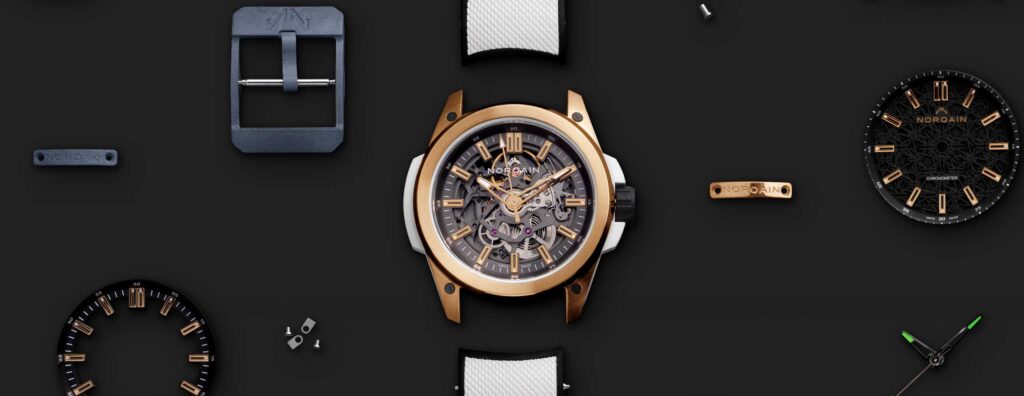Breitling
Breitling Navitimer 1 Automatic 38 and the History of the Slide Rule Watch
Breitling
Breitling Navitimer 1 Automatic 38 and the History of the Slide Rule Watch
Do the Math
In the year 1550, Scotland was in turmoil. The English were retreating from the borders after an unsuccessful attempt to force a union, leaving the Scots in danger of control from France – an alarming prospect for the Protestant nation. John Napier was born into this uncertainty, the first son of a prominent family, whose father would go on to run the Scottish Mint. Napier studied at Edinburgh University but never graduated, leaving early to pursue his education in Europe.
His passion for astronomy required time-consuming calculations of very large numbers which fuelled his search for a simpler method. Twenty years of research led him to logarithms which were first outlined in 1614. In essence, logarithms are the opposite of exponentials, where the intervals on a scale would get closer together the higher the value rather than further apart – both the Richter Scale and the decibel scale are examples. He went on to invent a mechanical aid for using logarithms in calculation called “Napier’s Bones”, his active mind also leading him to invent weapons of war including mirrors for burning ships at a distance, area-effect artillery and primitive tanks.
Magic Stars
The first actual slide rule was created by William Oughtred, a Church of England Rector, Fellow of Kings College Cambridge, teacher of mathematics and a contemporary and correspondent of Edmund Gunter. He simply took two Gunter rules and slid them alongside each other, eliminating the need for dividers. He also invented a circular slide rule but became embroiled in a dispute over priority with one of his students. His mathematics and the instruments that went with them were described in his book The Circles of Proportion and the Horizontal Instrument, 1632. Oughtred also invented a new kind of sundial which still bears his name.
Over the centuries, the slide rule was refined with additional functions and scales added. New versions were developed by the likes of Isaac Newton, Matthew Boulton and James Watt. The final form that we would recognise today was designed in 1850 by a French army officer, Amédée Mannheim.
With a circular slide rule being such an early innovation, it would seem natural to combine the rule with a time-telling device, but it took until the late-19th century for this to happen, with the appearance of the Meyrat & Perdrizet French pocket watch with slide rule.
The Three Rules
While not the first to apply for a patent, the first to produce a product for sale in 1940 was Mimo, a company later to be absorbed by Girard-Perregaux, followed almost immediately by Breitling, and four years later by Juvenia. Each watch interpreted the slide rule slightly differently.
On its three-hand watch, Mimo used the classic logarithmic scales that increase clockwise, referred to as C and D. The Breitling used one scale that increased clockwise and one that increased anticlockwise, referred to as C and C1. This may have been to avoid copyright infringement but also the C1 scale could be used with the chronograph as a tachymeter.
It is interesting to note that, unlike the rest of its Navitimer 1 family, the 38 automatic loses its innermost scale, the bezel becoming more like the original Mimo 1940 version. It may not be the first Navitimer without a chronograph, but it is the first Navitimer to have a slide rule not based on the E6B flight computer. Under Georges Kern, it seems that Breitling can break the rules and adopt novel ones.
E6B “Whizz Wheel”
Invented by US Naval Reserve Pilot Philip Dalton in the early-1930s, the E6B was named after its original part number for the US Army Air Corps. It was used to calculate ground speed, fuel use, wind drift and several other problems.
A casualty of history and the forgotten hero of so many important events, the crew of Apollo 11 –NASA’s Lunar Lander space vehicle – carried slide rules, for the first time in history, into space and onto the moon in July 1969. The slide rule of choice for Neil Armstrong, Buzz Aldrin and Michael Collins was the aluminium pocket Pickett 600-T Dual Base Log Log. The slide rule’s place in space travel is confirmed by retiree Norman Chaffee, who worked on the spacecraft propulsion system, and says: “We went to the moon with slide rules. I didn’t even have my first full-function calculator until 1972.”










